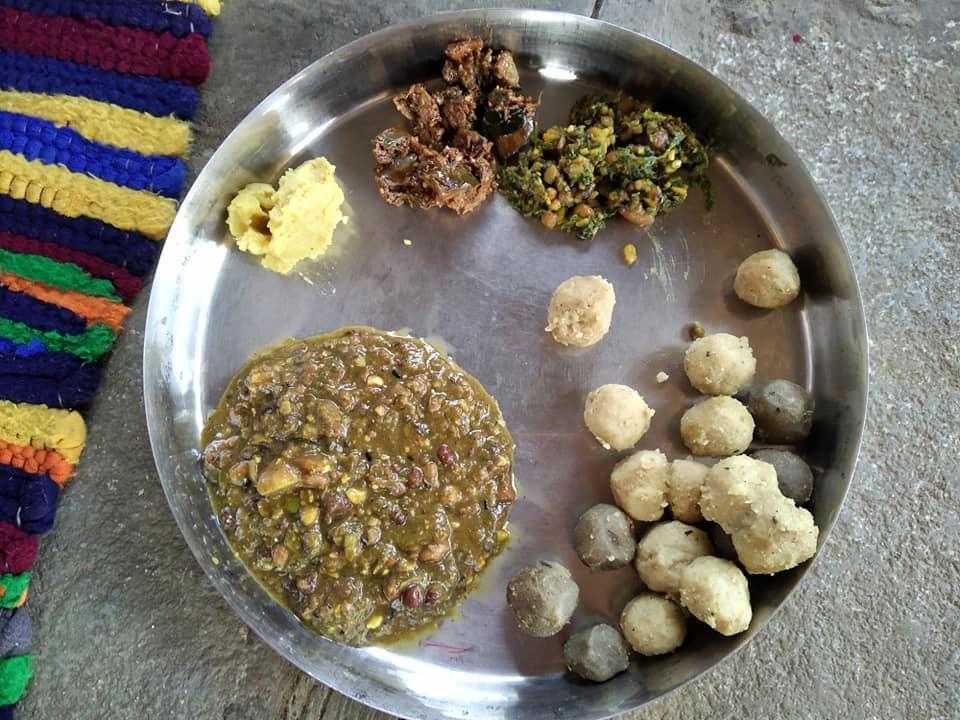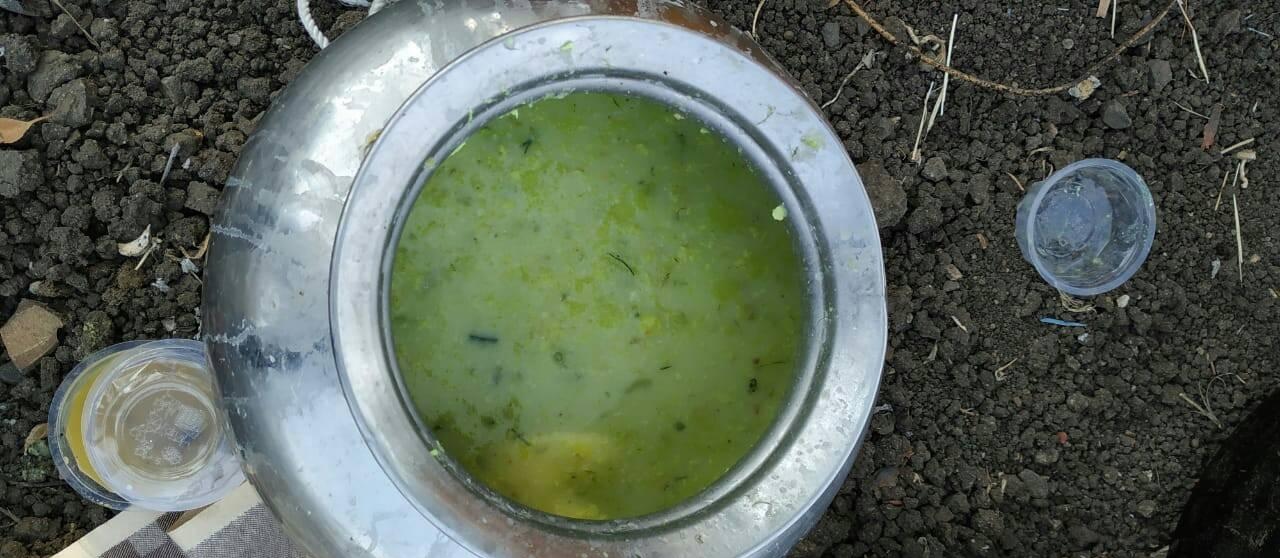Contents
- Traditional and Modern Eating Practices
- Meals of the Day
- How Spicy is the Food?
- Local Produce
- Pickles
- Tiffin Boxes
- Festival and Seasonal Delicacies
- Amavasya
- Wedding Food
- Prasad and Bhandara
- Smoking, Drinking and Substance Use
- Local Culinary Traditions
- Osmanabadi Mutton
- Kunthalgiri Pedha
- Unde
- Ambil
- Gargatta
- Eating Out
- Street Food
- Taj Hotel
- Usman Tea House
- Roma Hotel
- Samadhan Dhaba
- Local Worker Cooperatives / Self Help Groups
DHARASHIV
Food
Last updated on 3 November 2025. Help us improve the information on this page by clicking on suggest edits or writing to us.
Dharashiv district, located in the southeastern part of Maharashtra, is recognized for its challenging yet fertile land. Despite being a small portion of the state, it holds immense historical and geographical significance. Bordering Bidar and Gulbarga (Kalaburagi) districts in Karnataka, the district’s food culture is a mix of cuisines and spices from Maharashtra and Karnataka.
Traditional and Modern Eating Practices
Traditionally, people of Dharashiv consumed a variety of dishes made from jowar and bajra, such as bhakri, Thecha (spicy chutney), Pitla (gram flour curry), and leafy greens like spinach and chukka. Different types of rice dishes are also prepared here, including Chitranna (lemon rice) and Bishi Byali Anna (soft thick rice). Each household has its own way of preparing these dishes. Some dishes, like chitranna, are tangy and aromatic, often flavored with tamarind, giving them a unique taste.
When it comes to the consumption of milk, most people in Dharashiv prefer milk from gaushalas, a trend that has persisted over time, even with the option of packaged milk. Overall, the essence of traditional cuisine has not changed much in the district.
A slight change has been noticed in the activity of meal preparation. While traditionally, the task of cooking food fell primarily on women, this practice has witnessed some change in the district. Although women are the primary cooks at home, some men also contribute to meal preparation.
Meals of the Day
Meal times are typically structured with breakfast around 8:00 am, lunch around 1:00 pm or 2:00 pm, and dinner around 8:00 pm. After meals, most people enjoy badishep, while older individuals prefer supari (both are eaten as a mouth freshener). In addition to these three main meals of the day, people generally have a tea or coffee break between lunch and dinner. The beverage in the evening is usually accompanied by snack items, often referred to as namkeen. In the areas of Umaraga and Udragir, peanuts are widely popular. It is noteworthy that in the district, peanuts are used in various fried snacks, making them a beloved food item. Some other snacks include Bishi Byali (a simple rice dish), Hundi Palya (a simple and delicious sabji or curry that can be served along with jawar roti or chapati), Muddi Palya (a type of bhaji made from green leafy vegetables combined with moderately spiced lentils, crispy garlic & crunchy nuts), Peep Aaysa (puri kheer), Saranna, Majgianna, and thin, crispy papads, which are usually served with peanut chutney.
How Spicy is the Food?
Spice levels in Dharashiv's cuisine are moderate. According to locals, younger people tend to prefer spicier foods, while older individuals favor milder dishes.
Local Produce
Historically, Dharashiv has been an agricultural district, with major crops including jowar, sunflower, gram, sugarcane, and tur. Today, jowar remains the highest-producing crop in the district. Further, the district has been known for the production of khawa. Prepared with milk, khawa is widely used in local sweets, such as Pedha, especially in areas like Bhoom, Paranda and Washi.
![Production of Khawa[1]](/media/culture/images/maharashtra/dharashiv/food/production-of-khawa1-9c86590d.png)
Pickles
The district's pickle varieties include mango, lemon, and chilli pickles, though none are uniquely popular.
Tiffin Boxes
School-going Children usually carry home-cooked food in their tiffins, though some eat khichdi prepared at school. In the district’s Anganwadis, children are often served lapsi, a sweet dish made with grain flour or broken wheat, ghee, milk, and dry fruits.
Festival and Seasonal Delicacies
Amavasya
Amavasya is celebrated with much excitement in Dharashiv, marked by the traditional pairing of Unde (boiled pearl millet balls) and Ambil (a spicy buttermilk drink different from mattha). Cooking is done a day before, while the festival day is spent joyfully in the fields with family and friends. Schools remain closed, many take leave from work, and those living away return home. A special bhaaji made with 24 vegetables and garlic tadka is served with bhakri and mango chutney, alongside sugarcane, pumpkin, berries, peanut ladoos, wheat kheer, spiced rice, and tangy buttermilk. Unde and Ambil originate from Karnataka and are commonly prepared by Kannada-speaking households in both Karnataka and Dharashiv. The two are best enjoyed together by dipping Unde into Ambil for a balanced flavor.


Wedding Food
Weddings in Dharashiv feature elaborate meals with dishes like potato bhaaji, Vanga (brinjal) Masala, Masale Bhaat, bhaaji, chapati or puri, papdi, mat, and mattha. Common sweets include Gulab Jamun and Boondi Ladoo, which are often served at the end of the meal.
Prasad and Bhandara
Religious sites in Dharashiv offer various prasad items such as Lahya, Pedha, and Bhuga. At the Kal Bhairav Mandir in Tuljapur, mutton is traditionally offered as prasad, breaking the common belief of separating meat from religious offerings. During communal meals or bhandaras, dishes like Kadi Bhat, Bhuga, Lapsi, Chapati, potato bhaaji, and Vanga masala are commonly served, with the menu staying consistent over the years.
Smoking, Drinking and Substance Use
Alcohol consumption is moderate in Dharashiv, with traditional local varieties like Hathbhatti daru being common. This type of desi liquor is made using a hand furnace and ingredients like moha flowers, sugarcane or date palm juice, sugar, linseed, maize, unripe grapes, potatoes, rice, and spoiled oranges.
Local Culinary Traditions
Osmanabadi Mutton
![Osmanabadi Mutton[2]](/media/culture/images/maharashtra/dharashiv/food/osmanabadi-mutton2-0e468a5c.png)
This flavorful meat dish is made using mutton from the Osmanabadi sheli, a breed well-known across Maharashtra for its tender meat. The preparation starts by boiling the mutton and then simmering it in a spicy rassa or sherva made with onions, garlic, ginger, and local spices like kala masala and red chilli powder. The broth is cooked slowly to deepen the flavor. It is commonly served with bhakri and sides like sliced onion, roasted peanuts, and garlic chutney. This dish, made with local mutton in Tuljapur, is especially popular in Tuljapur, where it is also offered as prasad at the Kal Bhairav Mandir. Many dhabas in Tuljapur are known for serving this mutton with generous portions of spicy gravy, bhakri, and accompaniments like onion, peanuts, and garlic chutney. For meat lovers in the region, Tuljapur’s mutton holds a strong reputation for its rich taste and spice blend.
Kunthalgiri Pedha
Kunthalgiri Pedha, originating from North Dharashiv, is a sweet unique to the district. Made from Gavran Khawa and sugar, it has a thick, semi-soft texture and rich flavor. The pedha has gained recognition beyond Maharashtra, with a Geographical Indication (GI) tag, identifying the sweet as originating from Dharashiv. A similar sweet, the Pathrud Pedha, follows the same recipe and is locally popular.
Unde
Unde are savory balls made from a mix of bajra and jowar flour, seasoned with local spices, then shaped and steamed or boiled. They are traditionally eaten with Ambil on the occasion of Vel Amavasya.
Ambil
![Ambil[3]](/media/culture/images/maharashtra/dharashiv/food/ambil3-6f119fcb.png)
Ambil is a unique homemade drink made by mixing fermented buttermilk with finely ground wheat flour and chopped coriander. It is especially popular during summers for its cooling effect. Unlike regular buttermilk or mattha, Ambil has a tangy, spicy taste and a thicker texture. It is an essential part of the Vel Amavasya meal in Dharashiv, served with Unde and other festive dishes. Originally from Karnataka, Ambil is commonly prepared in Kannada-speaking households across Dharashiv, highlighting the region’s shared culinary traditions.
Gargatta
![Gargatta bhaaji[4]](/media/culture/images/maharashtra/dharashiv/food/gargatta-bhaaji4-904a3106.png)
Gargatta is a thick, tangy spinach curry popular across Dharashiv. Fresh spinach is boiled and thickened with chickpea flour, then seasoned with mustard seeds, cumin, jaggery, peanuts, grated coconut, and local spices. Tamarind or sugar is sometimes added for extra flavor. A garlic tempering is added at the end, giving the dish its distinct taste. Different from regular spinach curries, Gargatta stands out for its bold, rustic flavors and hearty texture.
Eating Out
Street Food
Dharashiv offers a vibrant array of street food, ranging from classic Maharashtrian snacks to North Indian and Chinese dishes. Vada pav, a spicy potato patty served in a bun, is widely popular across Maharashtra and a common sight here. Bhel, a mix of puffed rice and chutneys served either wet or dry, reflects North Indian street food traditions. Pav Bhaaji, made from mashed vegetables served with buttered bread, is another local favorite.
Distinct to Dharashiv’s streets is Nilanga Rice, a flavorful rice dish enjoyed by many. Other popular items include Ragda Patties, spiced potato patties with chickpeas; Kacchi Dabeli, a spiced potato-filled bun; and Bhaji, vegetable fritters served hot. Seafood lovers enjoy Machhi Fry, while Anda Burji (spicy scrambled eggs) and omelettes are common quick bites. Pani puri, hollow puris filled with spicy water, and Shev puri, a crunchy, tangy snack, are also widely relished. Kachori, fried pastries stuffed with spiced fillings, can be found at several street corners across the district.
Taj Hotel
The Taj Hotel is renowned for its signature Gulab Jamun, a popular sweet delicacy of the district. Made from khawa, maida, and sugar, these gulab jamuns are larger than usual and come in both elongated and round shapes. Known for their soft texture and delicate sweetness, they are expertly browned and soaked in sugar syrup. The tradition dates back to the 1950s and 60s with Sindhi Durbin’s famous Gulab Jamun, continuing today at the Taj Hotel, established in 1978.
Usman Tea House
Located near Dharashiv’s bus stand, Usman Tea House has long been a favorite spot for locals. The shop serves authentic Marathwadi-style Gulab Jamun alongside hot tea and breakfast items. The business has expanded to two or three branches, but the original location remains popular for its unmatched combination of piping hot gulab jamuns and strong tea. Many visitors come specifically to enjoy this comforting pairing.
Roma Hotel
Roma Hotel is well-known in Dharashiv for its breakfast offerings, especially Puri Bhaaji, a local favorite. Situated about 550 meters from the Dharashiv bus stand on the Beed-Solapur road near Nehru Chowk, it is easily accessible for residents. Besides Puri bhaaji, the Roma hotel offers a variety of Maharashtrian and South Indian breakfast dishes, including idli, Dosa, Poha, and Upma, attracting a steady morning crowd.
Samadhan Dhaba
On the route from Dharashiv to Tuljapur, Samadhan Dhaba has become popular among locals for traditional Maharashtrian fare. The dhaba serves bhakri, thecha, which is a spicy chutney made from green chilies, peanuts, and garlic pitla, a besan and onion curry, and Vangi Bhaaji, an eggplant preparation. These dishes satisfy the cravings of visitors seeking authentic flavors of the region.
Local Worker Cooperatives / Self Help Groups
Self-help groups in the district are known for producing a variety of popular snacks. These include kurdai, papad, papdi, jwarichi papdi, shevaya (local noodles), shabu chakli, bajra papdi, sandga, and chips. Their products are widely appreciated for their traditional flavors and quality, supporting local livelihoods while preserving regional culinary heritage.
Last updated on 3 November 2025. Help us improve the information on this page by clicking on suggest edits or writing to us.